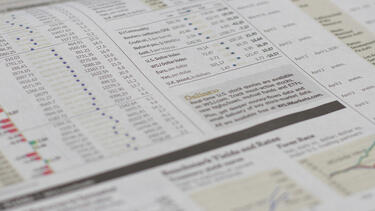Can We Have Economically Secure Retirements?
The end of defined-benefit pensions and a volatile stock market have made many Americans skeptical that they can retire comfortably. Is a new model emerging for how we plan for retirement? A panel of experts and practitioners talks about policies to help us bolster our retirement savings.

By Conrad de Aenlle
“I’ve got enough money to last the rest of my life…as long as I die tomorrow.” The old joke may resonate with retirement savers these days, even if they don’t find it funny. The responsibility to finance retirement is shifting substantially from employers to employees as defined-benefit plans, with pensions based on salary and years of service, give way to 401(k) and other defined-contribution plans whose value depends on the amount saved and returns earned in the markets.
The added responsibility comes amid elevated risk for investors. Stocks are near all-time highs, but only after two bear markets in the last 15 years each knocked more than half the value off share prices. It’s no wonder, after taking such a wild ride just when they had to get behind the wheel, that many Americans question whether they can retire comfortably. It’s a daunting prospect, but a panel of experts and financial practitioners in a Yale SOM webinar on April 8 concluded that it’s still feasible through innovative savings mechanisms.
One reason that workers feel insecure is simply that they’re not saving enough. Lori Lucas, head of the defined-contribution practice at Callan Associates, an investment consultancy, highlighted a large gap between contribution levels in workplace plans and what plan sponsors consider appropriate. More than four out of five respondents polled by the Plan Sponsor Council of America said employees should be saving at least 10% of their salaries, yet the average rate in 2013 was less than 7%.
James Choi, professor of finance at Yale SOM, acknowledged that workers may be somewhat responsible for their plight, but he also sees them as victims of circumstance. Many Americans aren’t covered by a workplace plan, he noted, and the ones who are face challenges they never confronted before. “Workers should be saving money and they’re not, [but] in the old days a lot of that savings and investment decision was outsourced to a defined-benefit plan,” Choi said. After working for a single employer throughout your career, “you’d [receive] a check every month for the rest of your life. In some ways it was pretty automated and paternalistic.”
Defined-contribution plans are becoming the norm in part because people are living longer but are not inclined to work longer, said Gerardo A. Guerra ’96, country manager and director general of the energy company Hess Mexico. American life expectancy has expanded by nearly 30 years in the last century and “we haven’t moved our retirement age from 65 throughout that period,” he said. “It just creates so much more pressure [to switch] people to a DC plan.”
One consequence of using defined-contribution plans is underperformance, he added. Because participants decide how their savings are invested and often make poor choices, returns are far lower than for defined-benefit plans.
Lucas mentioned another catalyst for the shift: Employees aren’t staying at the same company for decades, the way they used to. “The world has changed a lot in terms of the workforce,” she said. “Most people…do not work in the same organization for 30 or 40 years… One of the key advantages of a defined-contribution plan is that it’s portable.”
In response, plan sponsors, asset managers, and officials in Washington have devised solutions that coalesce around a single idea: If the landscape is changing, change it back, or at least create conditions likely to mitigate the savings shortfall—as Lucas put it, “DB-ize” defined-contribution plans. She credited a 2006 law with doing that by allowing employers to enroll workers automatically in 401(k) and similar plans, unless they opt out.
“By automatically enrolling people…earlier in their career, [participants] are saving longer [and] are defaulted into professionally managed solutions” that provide better returns at lower cost, she said. These include target-date funds, which gradually shift their allocation out of stocks and into bonds, which are believed to be less volatile and therefore safer, as a presumed retirement date approaches.
The popularity of target-date funds has soared because sponsors see them as a way “to address the behavioral biases of plan participants by harnessing inertia in a favorable way,” said Marc Mayer YC ’98, head of North American institutions at the investment-management firm Schroders.
We humans tend to make the easy choices; offering target-date funds helps ensure that those choices are the right ones, in Mayer’s view. The set-it-and-forget-it aspect encourages employees to emphasize retirement planning, as employers used to, and “capture this absolutely critical dynamic of constantly [saving] money,” he said. “That discipline, that process…has been a powerful force for good.”
Watch the discussion: